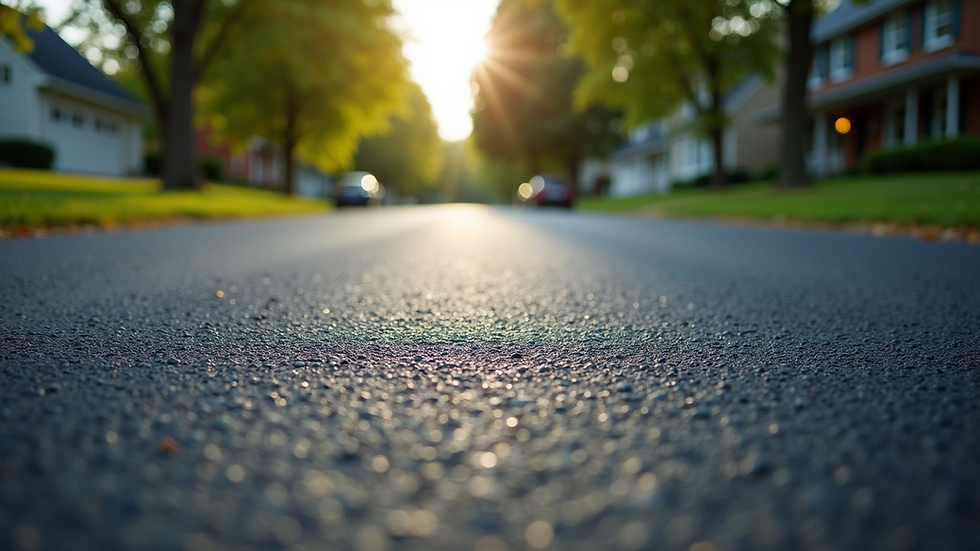Maintaining High-Quality Tar Surfacing
- 5 days ago
- 4 min read
Maintaining tar surfacing is essential for ensuring the longevity and aesthetic appeal of paved areas. Whether for residential driveways, commercial parking lots, or industrial access roads, a well-maintained tar surface provides durability and safety. This article offers professional tar surfacing tips to help preserve the quality of tar surfaces, reduce repair costs, and enhance property value.
Understanding the Importance of Regular Maintenance
Tar surfacing, while robust, is susceptible to damage from environmental factors and daily use. Exposure to sunlight, water, temperature fluctuations, and mechanical wear can cause cracks, potholes, and surface degradation. Regular maintenance is crucial to prevent minor issues from escalating into costly repairs.
Key maintenance activities include:
Routine inspections: Conduct visual checks for cracks, surface wear, and drainage problems.
Cleaning: Remove debris, dirt, and oil stains to prevent surface deterioration.
Sealing: Apply sealants to protect the surface from water ingress and UV damage.
Prompt repairs: Address cracks and potholes immediately to avoid further damage.
By implementing these practices, property owners can extend the lifespan of their tar surfaces and maintain a professional appearance.

Professional Tar Surfacing Tips for Longevity and Appearance
To achieve and maintain high-quality tar surfacing, it is essential to follow professional guidelines that address both installation and upkeep. These tips are designed to optimise the performance and visual appeal of tar surfaces.
1. Choose Quality Materials and Proper Installation
The foundation of a durable tar surface lies in the selection of high-quality materials and expert installation. Using premium bitumen and aggregates ensures better binding and resistance to wear. Proper compaction and layering during installation prevent premature failure.
2. Implement Effective Drainage Solutions
Water accumulation is a primary cause of tar surface damage. Ensuring adequate drainage through well-designed slopes and drainage channels prevents water pooling and infiltration, which can weaken the base and cause potholes.
3. Schedule Regular Seal Coating
Seal coating acts as a protective barrier against oxidation, water, and chemicals. Applying a seal coat every 2 to 3 years helps maintain surface flexibility and colour, reducing the risk of cracks and surface wear.
4. Address Cracks and Potholes Promptly
Small cracks can expand rapidly if left untreated. Use crack fillers and patching materials to repair damaged areas as soon as they appear. This prevents water ingress and further deterioration.
5. Control Heavy Vehicle Traffic
Heavy vehicles exert significant pressure on tar surfaces, accelerating wear and deformation. Where possible, restrict heavy traffic or reinforce the surface with thicker layers and stronger materials to accommodate load demands.
6. Maintain Clear Signage and Markings
Clear road markings and signage not only improve safety but also protect the surface by guiding traffic flow and reducing unnecessary wear in certain areas.
By adhering to these professional tar surfacing tips, property owners can ensure their surfaces remain functional and visually appealing for years.

The Role of Seasonal Maintenance in Tar Surfacing
Seasonal changes significantly impact tar surfaces. Understanding these effects and adjusting maintenance routines accordingly is vital for preserving surface integrity.
Summer Considerations
High temperatures cause tar to soften, making it more susceptible to deformation under heavy loads. UV radiation accelerates oxidation, leading to surface brittleness and cracking.
Recommendations:
Apply seal coats before summer to protect against UV damage.
Limit heavy vehicle use during peak heat hours.
Inspect for early signs of softening or rutting.
Winter Considerations
Cold temperatures cause tar to contract and become brittle, increasing the risk of cracking. Freeze-thaw cycles exacerbate damage by allowing water to penetrate and expand within cracks.
Recommendations:
Seal cracks before winter to prevent water ingress.
Clear snow and ice promptly to avoid prolonged moisture exposure.
Use appropriate de-icing agents that do not harm tar surfaces.
Spring and Autumn Considerations
These transitional seasons often bring increased rainfall, which can lead to water damage if drainage is inadequate.
Recommendations:
Inspect and clear drainage systems regularly.
Repair any winter damage promptly.
Schedule seal coating during dry periods.
Seasonal maintenance tailored to local climate conditions is essential for sustaining tar surfacing quality.
Practical Steps for Long-Term Tar Surfacing Care
Maintaining tar surfacing requires a combination of routine care and timely interventions. The following practical steps provide a structured approach to long-term surface management.
Conduct Biannual Inspections: Perform detailed inspections in spring and autumn to identify emerging issues.
Clean Surfaces Regularly: Remove leaves, dirt, and oil stains using appropriate cleaning agents.
Apply Seal Coats Periodically: Schedule seal coating every 2 to 3 years, or as recommended by professionals.
Repair Damage Immediately: Use professional-grade materials for crack filling and pothole patching.
Manage Traffic Loads: Implement traffic control measures to reduce stress on vulnerable areas.
Engage Professional Services: Consult experienced tar surfacing companies for installation, maintenance, and repairs.
Following these steps ensures that tar surfaces remain safe, durable, and visually appealing.
Enhancing Property Value with Expert Tar Surfacing Solutions
Investing in high-quality tar surfacing and its maintenance contributes significantly to property value. Well-maintained surfaces improve curb appeal, enhance safety, and reduce long-term repair costs. For those seeking reliable expertise, companies specialising in tar surfacing springs offer tailored solutions that meet specific property needs.
Professional services include:
Customised paving designs
Use of premium materials
Expert installation and compaction
Comprehensive maintenance plans
By partnering with reputable providers, property owners can ensure their tar surfaces deliver lasting performance and aesthetic benefits.

Sustaining Excellence in Tar Surfacing Over Time
Maintaining high-quality tar surfacing is an ongoing commitment that requires attention to detail and proactive management. By understanding the factors that affect tar surfaces and implementing professional tar surfacing tips, property owners can safeguard their investments.
Regular inspections, timely repairs, seasonal adjustments, and collaboration with experienced professionals form the foundation of effective tar surface care. This approach not only preserves the functional integrity of paved areas but also enhances the overall appearance and value of properties.
Ultimately, sustained excellence in tar surfacing reflects a dedication to quality and professionalism that benefits all stakeholders involved.


Comments